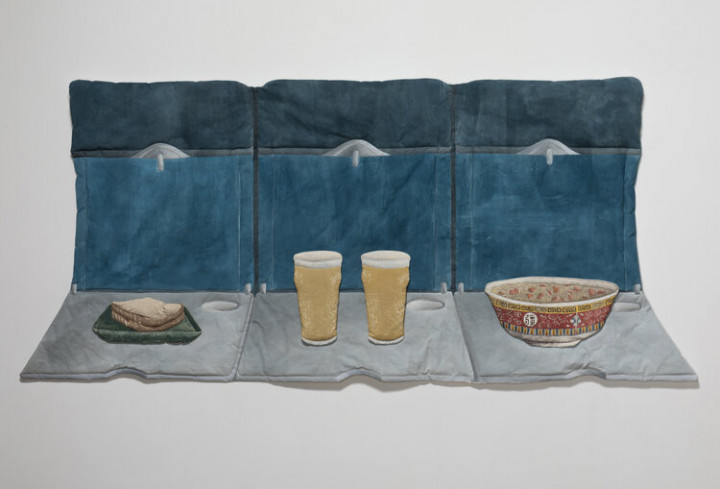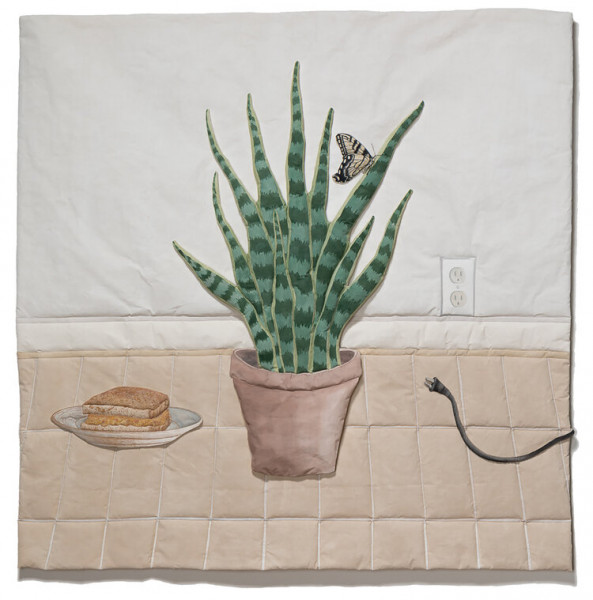
Above: Pile by Kay S. Healy. Photo by the artist.
Through her life-sized drawn, painted, and screen-printed fabric installations, artist Kay S. Healy investigates themes of home, loss, displacement and resilience with interview-based projects. Pile, her current exhibition at The Galleries at Moore through August 28, 2021, presents over 100 screen-printed, painted, and stuffed fabric objects that represent the complexities and cacophonous nature of a year marked by social uprisings and COVID shutdowns. Every piece in the exhibition has a story, many of which were inspired by interviews Healy conducted with people describing objects that captured their experiences and recent memories of the pandemic.
We recently spoke with Healy about her work, artistic influences, and Pile exhibition.
Your work mainly focuses on interview-based projects. What drew you to this style of conversational artmaking?
I was an art history major at Oberlin College and decided to start studying studio art shortly after seeing Pepón Osorio speak as a visiting artist. I was really struck by his installation Badge of Honor, which was inspired by conversations he videotaped of a son and an incarcerated father. I was very moved by how Osorio created work that had a concrete impact on individuals and communities, and it shifted my thinking on the relevance of artmaking. I also did an internship with Daniel Heyman while in graduate school at the University of the Arts. I was helping Heyman carve woodblocks that he created based on interviews he witnessed of people who were wrongly detained by the American military in Abu Ghraib. I was very influenced by his process and created my first interview-based project with senior refugees from Southeast Asia a year later.

Above: Fabric Objects by Kay S. Healy
What person, place and/or thing shaped you the most when you were first delving into your artistic practice?
My mom Julia Healy is an artist, so I was raised around her studio, art supplies, and giant art books. I resisted being an artist for a long time because it seemed so challenging to make a living from it. As I said earlier, when I saw the positive impact of Pepón Osorio's work, and concurrently took a course in mixed media sculpture, my professor Susan Umbenhour said I "had caught the bug."
Do you remember the first fabric object that you created? What is its significance to you now?
That same professor Susan Umbenhour had given me some leftover supplies from our mixed media sculpture class, including some fabric. A few years later when I was in grad school I was screen printing an armchair onto paper and decided to put that fabric under my screen. I handsewed it like a pillow and stuffed it with 10 pounds of polyester fiber fill, but it looked totally wrong. My mom showed me how to trapunto quilt it and bought me a sewing machine from Walmart for the holidays. That stuffed armchair is currently in our bedroom and my infant likes to grab the stuffed legs.

Above: Pile by Kay S. Healy
Pile presents over 100 stuffed fabric objects that represent the complicatedness of the pandemic and recent social uprisings. Can you tell us about one piece and its story that stands out to you?
They are all so powerful to me, but the one currently on my mind is about Emily. As part of the exhibition there is a free zine viewers can take that describes seven stories of objects in the installation. Emily's story is about her urine container, a seemingly odd or silly object, but actually very significant for many people. Emily's friend was diagnosed with a debilitating genetic kidney disease at a very young age, and Emily had been getting tests to see if she could donate her kidney. Emily had to collect her urine for 24 hours as part of the testing. She was not a direct match with her friend, but matched with a guy up in Maine, who had a donor who matched with someone else, who had a donor who matched with Emily's friend. The six surgeries were done in early August and Emily and her friend are doing really well. It was a scary process, but really beautiful to see the relief of the friends and family of everyone involved. As a mother to an infant daughter, the thought of someone donating their kidney to my child is overwhelming, and such a powerful act of humanity.
What was conducting interviews for Pile like, given that you weren’t able to meet with interviewees in-person?
It was really wonderful to be able to connect to people at a time when meeting new people was really challenging. I am actually continuing to do interviews with people about their pandemic objects because I think we all can benefit from processing and reflecting on these times. The pandemic has been an experience that has impacted all of us, but we have also had unique experiences within this time period, and I hope to learn about and depict as many different perspectives as I can. I think there is a tendency to rush and move on, but I see great value in taking the time to think about how our lives have changed over the last two years. Considering the objects that have had special significance to us, whether they be face masks or urine containers helps us process the experience and hopefully find meaning within the challenges everyone has faced.

Above: Fabric Objects by Kay S. Healy
Your work investigates “themes of home, loss, displacement and resilience.” Has your personal meaning of these words shifted for you since the start of the pandemic?
In my twenties I was very interested in domestic objects and stories of home probably because I felt so rootless. I have noticed a shift in this interest, perhaps as I've become more rooted in my community. I remember doing a project with seniors at NewCourtland's Germantown Home, a nursing facility up in Mt. Airy. I was interviewing a woman named Margaret about objects from her childhood home and she told me very plainly that objects don't matter, people matter. What I learned from her was that the objects I recreate are really stand-ins for people. When asked about significant objects most people pick something that is not monetarily valuable, but rather is connected to someone they love. For example, I just interviewed a woman who picked a cast-iron pot because she learned how to bake her own sourdough bread in it during the pandemic. While the pot is very pretty, it is not a family heirloom and was just something she bought online. The reason it was significant was because during the dark early days of the pandemic, she learned to make warm bread every morning that she would share with her husband and three children. It represents moments of comfort in a scary and uncertain time, and became more than just cookware for her.
Do you have any other upcoming exhibitions or projects that we should be on the lookout for?
I have a large panel called Victory being installed in the Outlook Gallery of the Minnesota Center for Book Arts in Minneapolis at the end of August 2021. I am also in a group exhibition of part-time faculty at the University of the Arts opening on August 27 called Cabin Fever. I am also continuing to interview people virtually about their pandemic objects through a sign-up form on my website.
